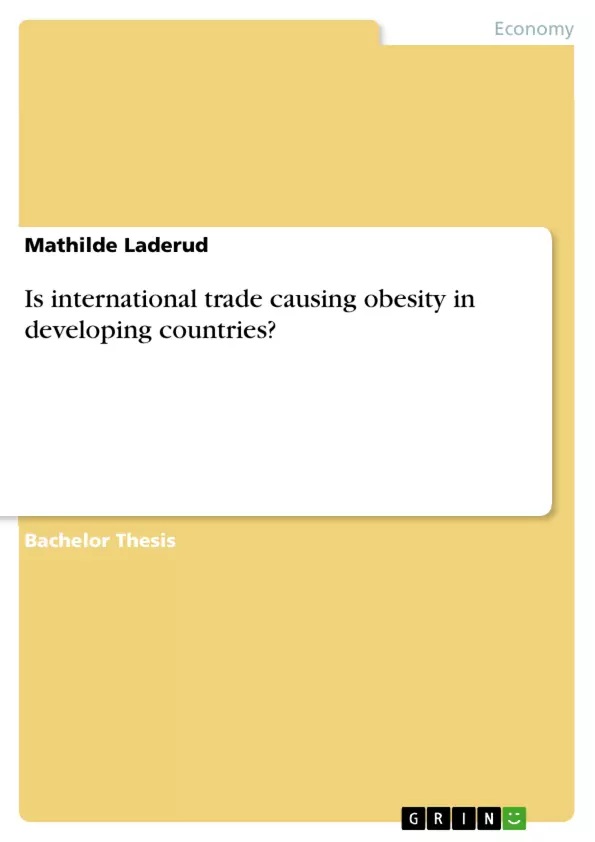This research paper was written as my final honors thesis in economics. I was questioning the somewhat sudden high rates of obesity found in many developing countries today. I found several reasons for why obesity has sky rocketed in the global south, finding that most trends leading to obesity derived from the western lifestyle.
One significant change between the western world and the developing world is that for the global south the transition to industrialization and development happened at a much faster pace. The sudden modernization has in many places led to extreme changes in behavior and lifestyle. The one trend that reoccured in most developing countries and had the highest effect on obesity rates was the infiltration of food products, mostly from western food corporations. I look at some specific practices made by companies like Nestle and others, as well as looking at behavioral changes in some of the worst hit areas like the Pacific Island nations.
Inhaltsverzeichnis (Table of Contents)
- Introduction
- Developing Countries And Trade Liberalization
- Diet Change And Obesity In The Developing World
- The Role Of Big Food Corporations
- Foreign Direct Investment
- The Pacific Island Nations, The Case Of Micronesia
- The Global Food System
- Liberalization Of Markets In Africa
- Trade Agreements: The North American Free Trade Agreement
- Trade Agreements: Central America-Dominican Republic Free Trade Agreement
- Obesity Levels And Socio-Economic Status
- Income, Price Fluctuations And Consumer Behavior
- Food Sovereignty- A Solution To Food Issues?
- Food Corporation Reaching The Remote Areas And Emerging Markets
- The Economic Theory: Supply And Demand
- Supply And Demand After Trade
- (WHO) Obesity Ranking: The Top Ten Countries Case Study
- Increased Imports Of Processed Food Over Time
- What Globalization Did To Consumer Behavior
- Future Of Processed Food On The Global Scale
Zielsetzung und Themenschwerpunkte (Objectives and Key Themes)
This research paper examines the relationship between international trade and obesity in developing countries. The study analyzes the influence of trade agreements, multinational corporations, and foreign direct investment on dietary patterns and obesity rates. The paper explores the role of the 'Western diet' and the impact of processed food imports on consumer behavior and health outcomes in developing nations.- The impact of international trade on obesity in developing countries
- The role of multinational corporations and foreign direct investment in shaping food consumption patterns
- The influence of trade agreements on the availability and affordability of processed foods
- The relationship between diet change and the rise of obesity in developing nations
- The economic and health implications of increased processed food consumption in developing countries
Zusammenfassung der Kapitel (Chapter Summaries)
- Introduction: This chapter outlines the global obesity epidemic, focusing on the increasing prevalence of obesity in both developed and developing nations. The chapter discusses the historical factors contributing to obesity, such as changes in diet and physical activity levels associated with industrialization and urbanization. The introduction sets the stage for investigating the relationship between international trade and obesity in developing countries.
- Developing Countries And Trade Liberalization: This chapter explores the role of trade liberalization in promoting economic growth in developing countries. The chapter discusses how globalization and increased trade have led to an influx of Western-style goods, including processed foods, into developing markets. The chapter also highlights the potential for trade liberalization to exacerbate inequalities and create challenges for developing nations.
- Diet Change And Obesity In The Developing World: This chapter examines the factors driving dietary changes and the rise of obesity in developing countries. The chapter discusses the influence of the 'Western diet', the increasing availability and affordability of processed foods, and the impact of these changes on public health. The chapter also highlights the vulnerability of low-income populations to unhealthy dietary choices due to limited access to affordable and nutritious food.
- The Role Of Big Food Corporations: This chapter explores the role of multinational food corporations in shaping global food systems and influencing consumer behavior. The chapter discusses how these corporations have leveraged low prices and aggressive marketing strategies to penetrate developing markets and promote the consumption of processed foods. The chapter also examines the role of government subsidies in supporting agricultural production and potentially influencing food prices.
- Foreign Direct Investment: This chapter analyzes the impact of foreign direct investment (FDI) on food systems and obesity in developing countries. The chapter examines how FDI, particularly in the retail sector, has contributed to the spread of supermarkets and fast-food chains in developing nations. The chapter discusses the potential consequences of FDI for local food production, consumer preferences, and public health.
- The Pacific Island Nations, The Case Of Micronesia: This chapter focuses on a specific case study of the Pacific island nations, with a particular emphasis on Micronesia. The chapter explores the unique challenges faced by these nations in terms of food systems and obesity rates. The chapter analyzes the impact of globalization, trade liberalization, and the influx of processed foods on dietary patterns and health outcomes in this region.
Schlüsselwörter (Keywords)
This research paper focuses on the key concepts of international trade, obesity, developing countries, multinational corporations, foreign direct investment, diet change, processed foods, and global food systems. The study examines the relationships between these concepts, exploring how trade, globalization, and economic development impact dietary patterns and health outcomes in developing nations.- Quote paper
- Mathilde Laderud (Author), 2014, Is international trade causing obesity in developing countries?, Munich, GRIN Verlag, https://www.grin.com/document/288762



